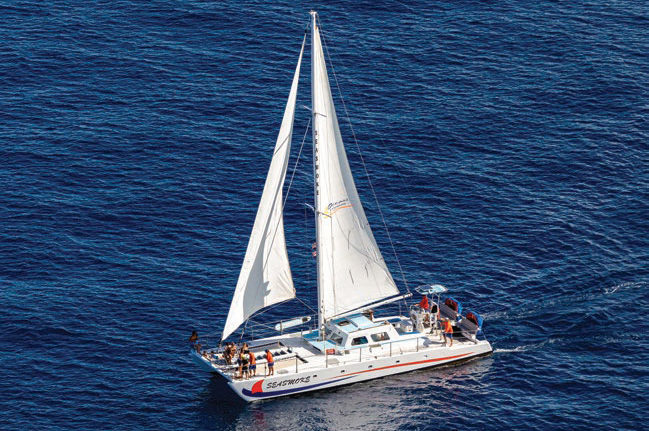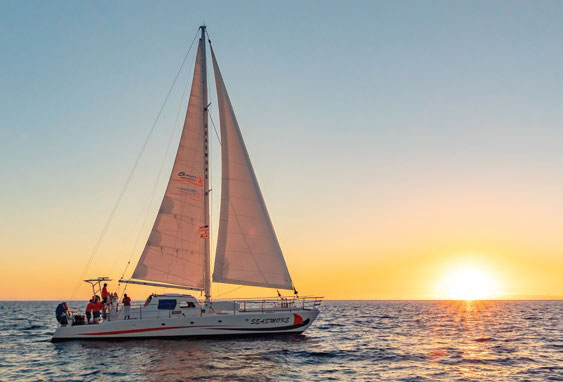Ocean faring has been a way of life for the Polynesian peoples throughout the Pacific since time immemorial. Indeed, those who originally populated the Hawaiian islands centuries ago undertook long ocean voyages in double-hulled sailing canoes to get here in the first place. Once here, their canoes were crucial for everything from fishing for sustenance to transportation around and between the islands.
In more recent years, and with great technological advances, sailing the ocean blue has become a popular leisure activity, as well as a competitive sport, with dozens of boats pushing out on weekend days from any given harbor, and races such as the Transpac (San Pedro, Calif., to Honolulu), which started in 1906, drawing entries from around the globe.
At Waikoloa Beach Resort, guests with a penchant for getting out on the water can sign up with Ocean Sports (HawaiiOceanSports.com) for snorkel cruises, whale watching cruises, sunset sails, and exclusive charters … and maybe experience a small part of history in the process.
A Racing Legend
Though today she serves as a comfortable snorkel and whale watching cruise vessel, there was a time that Seasmoke was the fastest boat on the water.
“Seasmoke is our ‘flagship’ catamaran,” says Ray Gallegos, Ocean Sports’ General Manager, referring to the historic 58-foot boat the company owns and uses for guest excursions. “We do brag about her history during every charter.”
Seasmoke, it turns out, was commissioned in 1966 by actor James Arness, who played Marshall Matt Dillon on the famous 1960s television show, “Gunsmoke.” Arness, an avid sailor, asked Rudy Choy of C/S/K Catamarans to build him “the fastest boat on the water.” An early advocate of catamarans and trimarans, Choy built Arness a cat that did indeed blow past its competition.
Arness entered his new boat in the 1968 Multihull Transpac — a California-to-Hawai`i event co-founded in 1964 by the Outrigger Canoe Club and the Ocean Racing Catamaran Association, as the “original” Transpac didn’t allow multi-hulled entries until 1995 — and that year, Seasmoke proved her speed and prowess by arriving at Diamond Head buoy a day-and-a-half ahead of every other boat in the race. She showed similar dominance for the next several years.

“She doesn’t compete in cross-ocean sailing races anymore,” Gallegos says. “When she was first racing in the Transpac, she had over 5,000 square feet of sail. As a comparison, we’re currently only allowed to run 879 square feet of sail. Since her racing days, a lot of hardware has been added to the boat too, including her engines, which make her much easier to navigate when on a whale-watch cruise, for example. Saying that, occasionally she’ll be chartered to run a sailing regatta with our other catamaran, Manu Iwa, and perhaps one or two other Big Island sailing catamarans. These aren’t serious races, but Seasmoke always holds her own.”
In time, Arness turned to other pursuits and donated the boat to the Sea Scouts (similar to Boy Scouts and Girls Scouts, but on the water) in California. The boat eventually was sold and began running as a charter catamaran. In 1981, she was acquired by Ocean Sports when they first opened operations on the Big Island. She left for Maui in 1984, but, says Gallegos, “we got her back again in 1993 … and we’re never letting her go!”
Up She Rises
Today’s racing boats are significantly faster than Seasmoke was in her heyday. When she crossed the finish line in the 1968 Transpac, for example, her elapsed time was 10 days, 9 hours. The fastest elapsed time for a multi-hull in the 2019 Transpac was 4 days, 11 hours … an improvement of almost six days!
It’s also easy to forget that it wasn’t that long ago that catamarans and trimarans were unproven technology. An article in the May 6, 1968, issue of Sports Illustrated by Hugh Whall, titled “Hey Ho and Up She Rises” discusses the then-new concept of multi-hulled sailing vessels.
“Innovation in any form has always been met with distrust at sea,” Whall wrote. “A traditionalist by training and temperament, the blue-water sailor, out of sight of land and dependent utterly on his vessel, has too much at stake to cast aside lightly the proved and the practical. Yet there is always within him the urge to sail faster and farther, with less effort and more comfort.
 “That urge in recent years has been gratified by a growing fleet of oceangoing sailboats that substitute two or even three hulls for the traditional single hull. Roomy, comfortable, often cheaper to build than ordinary craft, multi-hulled catamarans and trimarans can swoop down combers in the open sea at speeds of 20, 25 or even 30 knots — speeds unimagined in even the fastest 19th-century clipper ships.”
“That urge in recent years has been gratified by a growing fleet of oceangoing sailboats that substitute two or even three hulls for the traditional single hull. Roomy, comfortable, often cheaper to build than ordinary craft, multi-hulled catamarans and trimarans can swoop down combers in the open sea at speeds of 20, 25 or even 30 knots — speeds unimagined in even the fastest 19th-century clipper ships.”
The speed and excitement of the new craft design, Whall wrote, “won over such previously dedicated monohull men as TV’s Jim Arness, a longtime blue-water sailor.”
The passion Arness had for sailing and Hawai`i is still felt to this day. “This story brings me back to some pretty fantastic memories,” says Becky Ryan, Sales and Marketing Administrator, Waikoloa Beach & Kings’ Course. “My dad met Mr. Arness and his son while surfing at Makaha (`Oahu) and they became acquainted and would surf together when James was on island. Realizing my dad’s love for the sea, Arness invited us for a sail. I was six or seven, and it was the first time I had ever been on a catamaran and it was amazing. I already shared my dad’s love of the ocean and sailing but, I fell even harder that day. It is really nice to see the old picture of Seasmoke with her sails full in the wind. Those are memories I’ll carry forever.”
Though today she serves as a comfortable snorkel and whale watching cruise vessel, there was a time that Seasmoke was the fastest boat on the water.

